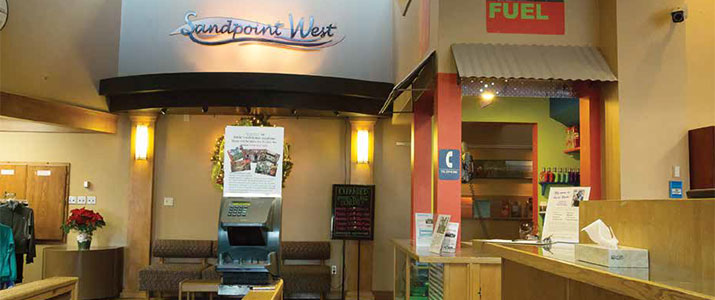
Fit for Security
Sandpoint West Athletic Club has used biometrics for 20 years and loves it
- By Don Helander
- Mar 01, 2014
 To say I’m sold on biometrics for athletic clubs after using the Hand-
Key since 1995 is an understatement. Back then, we were remodeling
our check-in area. While doing so, we decided to re-evaluate
our check-in software. We didn’t like membership cards because we
were spending too much time on people who had forgotten to bring
them; plus, it is very easy for a member to provide their card to a non-member. In
addition, there was the actual product cost and labor spent printing and distributing
cards. With many short-term memberships, that too was a cost we wanted to
reduce.
To say I’m sold on biometrics for athletic clubs after using the Hand-
Key since 1995 is an understatement. Back then, we were remodeling
our check-in area. While doing so, we decided to re-evaluate
our check-in software. We didn’t like membership cards because we
were spending too much time on people who had forgotten to bring
them; plus, it is very easy for a member to provide their card to a non-member. In
addition, there was the actual product cost and labor spent printing and distributing
cards. With many short-term memberships, that too was a cost we wanted to
reduce.
Around the same time, we discovered that a YMCA in Washington State was
successfully using biometrics. We visited them and learned that hand geometry
readers positively verify users by the shape and size of their hands by analyzing
more than 90 separate measurements of the hand’s length, width, thickness and
surface area. This information is compared against a previously stored “template”
in the reader’s memory allowing hand geometry technology to provide a fail-safe
method to ensure that the person who enters the club isn’t merely carrying someone
else’s access card or PIN.
Because HandKeys guarantee that the person requesting access is actually who
they say they are, we began to evaluate software and decided to work with Clubrunner,
a company that supports the HandKey check-in system.
We opened our remodeled check-in area in September 1995 with a new Hand-
Key and two types of software: “HandReader” operates the HandKey, while
“Clubrunner” runs our club. HandReader communicates with Clubrunner upon
each check-in to record all visits.
Getting Customers Onboard
Starting from scratch, enrollment consisted of assigning people a PIN number and
then instructing them to place their hand onto the platen of the HandKey three
times. Henceforth, to enter the club, they would only need to enter their PIN and
place their hand on the platen. They no longer would have to worry about cards.
Initially, some members were concerned about sanitary concerns; others had
privacy concerns. For those concerned with sanitary issues, we explained how the platen itself is infused with an antimicrobial coating that keeps it bacteria free. We also provided hand wipes for use after presenting one’s hand. That apprehension
quickly went away
With sanitary concerns extinguished, privacy concerns were next. We explained
that people often confuse biometrics with the systems they see on TV crime shows.
When considering the privacy concerns associated with biometrics, an important
distinction must be made between identification, a one-to-many match, and authentication,
a one-to-one match. It is vital that users understand the difference.
Identification. A system designed to identify a person compares a biometric
presented by a person against all biometric samples stored in the database. The system
identifies the individual, if the presented biometric matches one of the many
samples on file. This is a one-to-many match and is used by the police to identify
criminals, governments to identify qualified recipients for benefit programs and
registration systems for voting and licensing drivers. (This is the type of system we
see on TV crime shows.)
Authentication. A live biometric presented by the user is compared to a stored
sample previously given by that individual during enrollment, and the match is
confirmed. The hand geometry of the user is not stored in a database or on an ID
card. Instead, an algorithm is performed with points measured on the finger or
hand. The template that results from this equation is all that is stored.
Using this knowledge, we assured club members that when they enter an assigned
PIN, only that template is transmitted. When they present their hand, the reader
runs the authentication process to determine if the template that is stored matches
the biometric being presented. If there is a match, the person is authenticated.
A core group of enthusiastic members paved the way for the others. It was interesting
to watch. We have two lanes at our check-in: one for the express check-in
that uses the HandKey and the other for check-in by an attendant or when someone
has questions. Within weeks, the majority of our members wanted to use the
express lane.
Perhaps what impressed us the most, from a business standpoint, was how
much personnel time we gained. Using cards requires someone to be at the front
desk, exclusively devoted to check-in. Upon creating the express HandKey lane,
our front desk employee could attend to other duties such as answering phones,
signing people up for memberships and other member-related services. From a
dollars and cents perspective, an automated express check-in lane is cost effective.
From the Original HandReader to the Next One
Recently, we replaced the ID3D—which had checked in over 2 million members—
with a new reader, a Schlage HandKey II that is faster and has even better HandReader
software.
Our first challenge was to transfer existing member templates to the new
system. We had to get the system up and running, as we have over 400 visits
per day. With excellent tech assistance, we were able to transfer more than
2,000 hand templates, so when the Handkey II was up and running, everything
worked the same. It was great not having to re-enroll everyone and the members
were satisfied.
Also, for 18 years, I’ve been extracting numbers from the old ID3D HandKey
using Backhand, a DOS-based program, and matching them to our club’s system
software to account for membership changes. The new HandReader software—
HandNet for Windows—supports the HandKey II, so manually synchronizing the
numbers is no longer required. This compatibility is an incredible time saver.
Today, we have more than 2,000 users stored in the HandKey II. Using a 4-digit
PIN, we can assign up to 10,000 unique numbers. This means our members are
free to choose their own numbers, one they can easily remember with a four in five
chance that they will get the number they want.
Running the Club
Sandpoint West Athletic Club has different types of memberships, and some are
even time restricted. Since the HandKey II and Clubrunner records the time and
date that a member checks in, this is very easy to manage. Other members want to
buy a set number of days. This also is managed easily because the software automatically
reduces the member’s visits as he checks in.
Today, there is only one entrance and that requires only a single HandKey.
However, in the future, if expansion takes place, a second entrance may be needed.
HandNet for Windows will let us control and monitor two
or more HandKeys simply and easily. With one program, we
will be able to monitor activity and alarms on all readers while
controlling the access of each.
This article originally appeared in the March 2014 issue of Security Today.